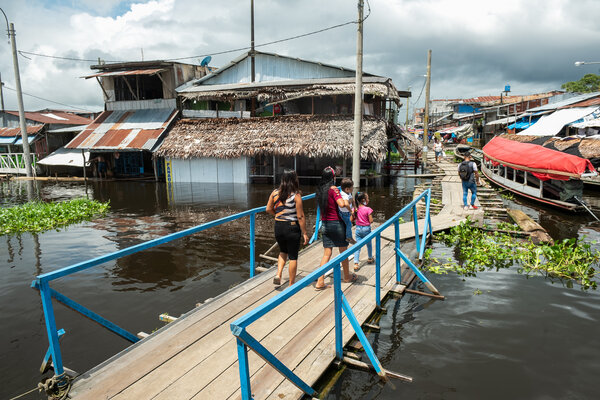Transmission characteristics
Of a total population of 32.2 million, 12.6 million people are at risk of malaria in Peru. There were 27,785 reported malaria cases (falciparum, vivax, and mixed) in 2022. About 82% of cases were due to P. vivax (22,856/27,785). A globally funded malaria control program ended in 2010 and malaria cases for P. vivax and P. falciparum increased from 2011, peaking in 2014.1
Malaria transmission is almost exclusively confined to the Amazon rainforest and the northern coastal region. In particular, the Loreto region in the Amazon rainforest in northeast Peru has high malaria endemicity. In Loreto, the only significant urban centre is Iquitos, with the remaining rural population in remote villages throughout the river system.1
In the northern Amazon, transmission is perennial but with marked seasonality following the heavy rainfall in November to April. Access to health services is limited in mostly rural populations involved in forestry, agriculture, logging, fishing and hunting.1 In the southern Amazon, transmission is seasonal following the heavy rains in December to April. The population is mostly rural and informal mining operations are common with limited access to healthcare.1 In the northern coast, there is seasonal transmission generally following the rains in December to March, but influenced by the El Niño Southern Oscillation climate pattern. In this region, settlements are more urban and peri-urban and the population has better access to healthcare, though many are involved in agriculture. Currently, only P. vivax is reported from this region.1
Primary malaria vectors in the Amazon are An. darling, An. benarrochi and An. triannulatus. In the northern coastal regions, An. albimanus is the primary malaria vector.
Surveillance
The aim is to investigate all confirmed cases of malaria. In 2022, reported malaria cases represent approximately 78% of estimated cases.1 Data is submitted on a weekly basis to a national epidemiological system.
The Peruvian Ministry of Health has established a strong National Network of Public Health laboratories classified into four levels: local, intermediate, regional, and national level. Light microscopy is the main method of diagnosis, performed for all febrile patients presenting to healthcare facilities.1 Active case detection is not done routinely. Surveillance is challenging in the most malaria-endemic regions dueto their remoteness and political and social factors, such as illegal gold mining.1 Chloroquine-resistant P. vivax was reported in Peru in a study conducted 1998–2001, but no recent data are available. Peru is part of the Amazon Network for Surveillance of Antimalarial Resistance (RAVREDA) and was supported by the United States Agency for International Development (USAID) through the Amazon Initiative against Malaria (AMI) project.1
2020 milestones/ malaria elimination
The incidence of malaria has increased since 2010 and Peru is not on target to meet the 2020 milestone of a ≥40% decrease in malaria incidence by 2020.1
Treatment policy for P. vivax
Chloroquine followed by primaquine 0.5 mg/kg for 7 days.2
Diagnosis and treatment is free of charge in the public sector.2
G6PD testing policy
G6PD testing before treatment with primaquine is not part of the national treatment policy.2
G6PD deficiency prevalence
The most frequent G6PD deficiency variant in Africa, known as G6PD*A−, seems to be also the most predominant in South America, and is thought to have been carried to South America in West African slaves. G6PD deficiency is thought to be very rare in Amerindians. Peru has a low prevalence of G6PD deficiency, estimated at ≤2%, likely explained by the majority of the population having an Amerindian genetic heritage. However, data are sparse and there are no data on the relative prevalence of G6PD-deficient variants.
